
may/june 2024 hivplusmag.com
BECAUSE YOU’RE MORE THAN YOUR STATUS
NEW
BLOOD
TODRICK HALL
ANTI-STI WEAPON?
AS ART OPRAH ON U=U
TODRICK HALL MUSICAL SUPERSTAR IS ALSO AN ALLY TO HIS COMMUNITY
IMPORTANT FACTS





(bik-TAR-vee)
MOST IMPORTANT INFORMATION ABOUT BIKTARVY
BIKTARVY may cause serious side effects, including:
Worsening of hepatitis B (HBV) infection. Your healthcare provider will test you for HBV. If you have both HIV-1 and HBV, your HBV may suddenly get worse if you stop taking BIKTARVY. Do not stop taking BIKTARVY without first talking to your healthcare provider, as they will need to check your health regularly for several months, and may give you HBV medicine.
ABOUT BIKTARVY
BIKTARVY is a complete, 1-pill, once-a-day prescription medicine used to treat HIV-1 in adults and children who weigh at least 55 pounds. It can either be used in people who have never taken HIV-1 medicines before, or people who are replacing their current HIV-1 medicines and whose healthcare provider determines they meet certain requirements.
BIKTARVY does not cure HIV-1 or AIDS. HIV-1 is the virus that causes AIDS.
Do NOT take BIKTARVY if you also take a medicine that contains:
dofetilide
rifampin
any other medicines to treat HIV-1
BEFORE TAKING BIKTARVY
Tell your healthcare provider all your medical conditions, including if you:
Have or have had any kidney or liver problems, including hepatitis infection.
Are pregnant or plan to become pregnant.
Are breastfeeding (nursing) or plan to breastfeed. Do not breastfeed if you have HIV-1 because of the risk of passing HIV-1 to your baby.
Tell your healthcare provider about all the medicines you take:
Keep a list that includes all prescription and over-thecounter medicines, antacids, laxatives, vitamins, and herbal supplements, and show it to your healthcare provider and pharmacist.
Ask your healthcare provider or pharmacist about medicines that interact with BIKTARVY.
This is only a brief summary of important information about BIKTARVY® and does not replace talking to your healthcare provider about your condition and your treatment.
POSSIBLE SIDE EFFECTS OF BIKTARVY
BIKTARVY can cause serious side effects, including:
Those in the “Most Important Information About BIKTARVY” section.
Changes in your immune system.
New or worse kidney problems, including kidney failure.
Too much lactic acid in your blood (lactic acidosis), which is a serious but rare medical emergency that can lead to death. Tell your healthcare provider right away if you get these symptoms: weakness or being more tired than usual, unusual muscle pain, being short of breath or fast breathing, stomach pain with nausea and vomiting, cold or blue hands and feet, feel dizzy or lightheaded, or a fast or abnormal heartbeat.
Severe liver problems, which in rare cases can lead to death. Tell your healthcare provider right away if you get these symptoms: skin or the white part of your eyes turns yellow, dark “tea-colored” urine, light-colored stools, loss of appetite for several days or longer, nausea, or stomach-area pain.
The most common side effects of BIKTARVY in clinical studies were diarrhea (6%), nausea (6%), and headache (5%).
These are not all the possible side effects of BIKTARVY. Tell your healthcare provider right away if you have any new symptoms while taking BIKTARVY.
Your healthcare provider will need to do tests to monitor your health before and during treatment with BIKTARVY.
HOW TO TAKE BIKTARVY
Take BIKTARVY 1 time each day with or without food.
GET MORE INFORMATION
This is only a brief summary of important information about BIKTARVY. Talk to your healthcare provider or pharmacist to learn more.
Go to BIKTARVY.com or call 1-800-GILEAD-5
If you need help paying for your medicine, visit BIKTARVY.com for program information.










BIKTARVY, the BIKTARVY Logo, ADVANCING ACCESS, GILEAD, and the GILEAD Logo are trademarks of Gilead Sciences, Inc., or its related companies. © 2023 Gilead Sciences, Inc. All rights reserved. US-BVYC-0357 11/23










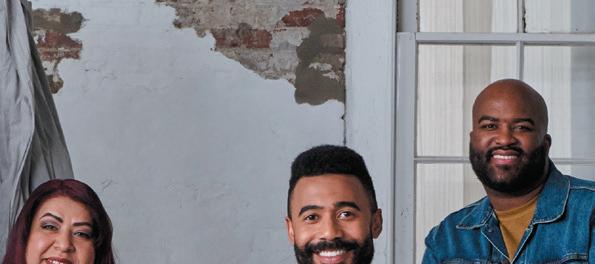





















Gilead is committed to helping you afford your medication no matter your situation.

If your healthcare provider has already determined that BIKTARVY is right for you, then the Gilead Advancing Access® program can help you explore potential coverage options.








If you’re eligible, you may be able to pay as little as $0 for your co-pay.*

If you do not have insurance, Advancing Access can help explore alternative support options. Call Advancing Access (1-800-226-2056) or go to HelpPayForBIKTARVY.com
Advancing Access specialists can help you understand your health insurance and Gilead medication costs.
Ask your healthcare provider if BIKTARVY is right for you.
Please see Important Facts about BIKTARVY, including important warnings, on the previous page and at BIKTARVY.com.




Scan here to learn more

People featured take BIKTARVY and are compensated by Gilead. * For commercially insured eligible patients only. See terms and conditions at GileadAdvancingAccess.com.
FEATURES
22 U ARE GOOD
Celebrating eight years of "undetectable = untransmittable."
24 SIGNED IN BLOOD
A new art exhibit examines how our relationship with the bodily fluid has evolved over the years.
BUZZWORTHY
6 ANGEL ON OUR SIDE
Honoring the life of brave activist Hydeia Broadbent.
8 KUDOS TO Q
A Drag Race season 16 star opens up about their HIV status.
9 PEP PEP HOORAY!
Does this "morning after pill" for STIs really work?
9 NOT ADDING UP
Certain communities are not receiving fair health care.
10 HIV VICTORY
One man fights the system and wins.
WELLNESS
20 FASTING FOR LIFE
Can moderate fasting help you live longer?
21 HEALTHY KIND OF LOVE
This gay therapist has some dating tips for you.


12
TOTALLY TODRICK
Musician, choreographer, and visual artist Todrick Hall is known for his dazzling music videos and Broadway performances, but he's also been a longtime ally to Black, LGBTQ+, and HIV communities.
TREATMENT
28 CAN'T RESIST
Battling drug resistance.
29 DOUBLING UP
Is this "combo" method the future of PrEP? 6
24
30 PIANO MAN'S PARTY
Elton's annual Oscar affair raises millions for HIV causes.

issue 160 con tents 2 MAY / JUNE 2024
JORDAN EAGLES/GETTY (EXHIBIT); LYN ALWEIS/THE DENVER POST VIA GETTY IMAGES (BROADBENT); ALEX G. HARPER (HALL)
THE COVER Todrick Hall photographed by Alex G. Harper PARTING
ON
SHOT


@outmagazine
editorial director NEAL BROVERMAN
editor in chief DESIRÉE GUERRERO
executive creative director RAINE BASCOS
EDITORIAL senior editor JOHN CASEY
senior copy editor TRUDY RING contributing editors ADAM D. BLUM, RICKY CORNISH MARK S. KING, GARY MCCLAIN
ART graphic designer MARIUSZ WALUS digital photo editor NIKKI AYE
EQUALPRIDE
EDITORIAL
editor in chief, the advocate DESIRÉE GUERRERO digital director, the advocate ALEX COOPER senior editor, the advocate JOHN CASEY sr. national reporter, the advocate CHRISTOPHER WIGGINS staff writer, the advocate & out MEY RUDE editor in chief, out DANIEL REYNOLDS digital director, out RAFFY ERMAC associate digital director, out & pride.com BERNARDO SIM managing editor, out traveler DONALD PADGETT editor in chief, pride.com RACHEL SHATTO community editor MARIE-ADÉLINA DE LA FERRIÈRE
ADVOCATE CHANNEL
senior executive producer of programming MARY SCHWAGER vp, women’s programming & host SONIA BAGHDADY vp, executive producer of entertainment TRACY E. GILCHRIST producer, host AARON DEANE producer, host LAPORSCHE THOMAS booking producer CAROLINE WEISS
senior producer BRIAN KELLEY producer CARA GLASS
host & producer JAYMES VAUGHAN
host & producer STEPHEN WALKER
host & producer RACHEL SMITH
climate change reporter, producer MICHAEL SMITH
chief video editor LAMONT BALDWIN
senior video editor RICHARD GACOVINO
chief video editor LUCY VALENTI
chief video editor WALTER COLVIN
ADVERTISING & SUBSCRIPTIONS
phone 212.242.8100
advertising fax 212.242.8338
subscriptions HIVPlusMag.com/subcontact
EDITORIAL
editor@hivplusmag.com

chief executive officer MARK BERRYHILL cofounder, equalpride MICHAEL KELLEY
chief financial officer JOE LOVEJOY
chief operating officer BERNARD ROOK
chief marketing officer MICHEL J. PELLETIER executive director of digital content KAYLA GAGNET
executive vice president, corporate sales & partnerships STUART BROCKINGTON
chief of staff CHRISTOPHER GO
vp & publisher, out, the advocate, & plus MARK ISOM vp, corporate sales JOE VALENTINO
ADVERTISING, BRAND PARTNERSHIPS & INTEGRATED SALES
vp, brand partnerships TIM SNOW senior director, brand partnerships ANDRAÉ BONITZER VIGIL-ROMERO
creative director, brand partnerships MICHAEL LOMBARDO managing director, corporate sales KAYLYN BLACKMORE managers, brand partnerships JOSE CARDENAS, ALEX HOFFMAN, ERIN MANLEY
editor, branded content NIC AUSTIN account manager, corporate sales & partnerships CARINA BUIE coordinator, sales & advertising administration LULU DROPO coordinator, brand partnerships JULEAN DEJESUS account manager, corporate sales MARCUS HOEY
ADVERTISING
vp, ad operations STEWART NACHT manager, ad operations TIFFANY KESDEN
MARKETING
manager, social media CHRISTINE LINNELL specialist, social media JADE DELGADO senior marketing designer ERIK BROCK
CIRCULATION
director of circulation ARGUS GALINDO
FINANCE/ACCOUNTING
controller, HR director PAULETTE KADIMYAN accounts receivable LORELIE YU
OPERATIONS
vp, technology and development ERIC BUI

FREE BULK SUBSCRIPTIONS FOR YOUR OFFICE OR GROUP
Any organization, community-based group, pharmacy, physicians’ office, support group, or other agency can request bulk copies for free distribution at your office, meeting, or facility. To subscribe, visit HIVPlusMag.com/signup. There is a 10-copy minimum.
FREE DIGITAL SUBSCRIPTIONS
Plus magazine is available free to individual subscribers — a digital copy of each issue can be delivered to the privacy of your computer or reader six times per year. We require only your email address to initiate delivery. You may also share your digital copies with friends.
To subscribe, visit HIVPlusMag.com/signup
NEED SUBSCRIPTION HELP?
If you have any questions or problems with your bulk or individual magazine delivery, please email our circulation department at Argus.Galindo@equalpride.com
Plus (ISSN 1522-3086) is published bimonthly by equalpride.
Plus is a registered trademark of equalpride.
Entire contents ©2024 by equalpride. All rights reserved. Printed in the
4 MAY / JUNE 2024
U.S.A.
UNDETECTABLE = UNSTOPPABLE

SCIENCE
VERSUS STIGMA. That’s the fight we continue to struggle with when it comes to our sexual health, especially when it comes to HIV. This is exactly why we annually celebrate U=U in Plus ’s May/June issue. The “undetectable equals untransmittable” movement has been going strong for eight years now and continues to gain momentum.
U=U simply means that people living with HIV who are on treatment and achieve an undetectable vir≠≠al load also has a zero chance of transmitting HIV to a sexual partner, even without the use of a condom. This scientific fact has not only helped greatly reduce the spread of the virus, it also mentally, emotionally, and sexually liberated people living with HIV. Read more about the history of U=U, the trailblazing activists behind it, and what Oprah Winfrey recently had to say about it on page 22.
In this issue we also celebrate some of our greatest allies in the fight against HIV and its stigma — like our talented cover star, Todrick Hall. Throughout his career, Hall has consistently given back to the people and communities closest to him. Recently, the award-winning musician and choreographer supported HIV causes by headlining the Florida AIDS Walk and Music Festival in March. Read more about this and what else Todrick’s been up to in our exclusive interview on page 12.
For a little more art and culture, flip to page 24 to learn about The Getty museum’s art exhibit that focuses on blood and society’s evolving relationship with the essential fluid. To see some more great images, check out our fun pics from Sir Elton John’s annual Oscar viewing party (page 30), which brought out the stars and the big bucks. The event raised record-breaking millions this year for HIV causes.
And we continue to share the latest news and stories that affect our world, like the sudden loss of HIV activist Hydeia Broadbent (page 6) and a Drag Race star opening up about living with HIV (page 8). Also read about new breakthroughs in HIV treatment and prevention (page 28) and helpful tips on how to navigate the dating world and stay sane (page 21).
I hope in these pages you’re able to find some helpful information, positive inspiration, and perhaps a little joy. Be well,

Dear Plus Readers,
Few narratives are as transformative and profound as the U=U movement. Undetectable equals Untransmittable is not just a medical fact; it is a beacon of hope, shattering the stigma and fear that have long shadowed the lives of those living with HIV. This simple yet powerful message underpins our every effort and story in this issue, reminding us of our incredible strides in HIV treatment and prevention.
Our cover story features Todrick Hall, an artist who embodies a spirit of courage and authenticity. His voice, literally and metaphorically, amplifies our shared message of love, acceptance, and the unyielding belief in one’s self-worth.
As you leaf through these pages, you’ll find stories that resonate with the core of U=U. From groundbreaking research and medical advancements to personal narratives of resilience and community outreach, each article is a thread in the vibrant tapestry of our collective experience. We aim to educate, inspire, and provoke thought, driving home the message that living with HIV today is a far cry from the narratives of the past.
This issue also serves as a clarion call to action. While we celebrate the transformative power of U=U, we are also reminded of the journey ahead. Stigma, discrimination, and misinformation remain barriers in our path. It is up to us to dismantle these obstacles and pave the way for a future where HIV is no longer a burden borne in silence but a condition met with compassion, support, and unwavering solidarity. Together, we are unstoppable.
With deepest gratitude and solidarity,
 Desirée Guerrero editor in chief
Mark Berryhill CEO, equalpride
Desirée Guerrero editor in chief
Mark Berryhill CEO, equalpride
HIVPLUSMAG.COM 5 COURTESY
FITZ
editor ’ s letter by desirée guerrero
(GUERRERO); ROLAND
(BERRYHILL)
a note from our ceo

HEAVENLY HERO
The world mourns the loss of activist Hydeia Broadbent , who bravely spoke out for children living with HIV when it was needed most.
BY DESIRÉE GUERRERO
Lifelong activist Hydeia Broadbent, who became the face for children living with HIV during the peak of the epidemic in the early 1990s, has died at age 39. Her adoptive father Loren Broadbent — who, alongside wife Patricia, raised Hydeia since she was six weeks old after being abandoned at a Las Vegas hospital — announced her passing on Facebook on February 20.
“With great sadness, I must inform you all that our beloved friend, mentor and daughter Hydeia, passed away today after living with Aids since birth,” wrote Loren in his post. “Despite facing numerous challenges throughout her life, Hydeia remained determined to spread hope and positivity through education around HIV/AIDS.”
The couple didn’t know of Hydeia’s diagnosis for the first few years of her life, CNN reports. When Hydeia was three years old, the family learned a woman with the same last name as Hydeia had also given to birth to a baby boy at the same hospital, and had left that child there as well. Both the mother and child tested positive for HIV. It was then that the Broadbents had Hydeia tested and she was diagnosed HIV-positive.
As she grew up, Hydeia, along with Ryan White, became the face of children with HIV and AIDS in the U.S. She made numerous TV appearances, including on The Maury Povich Show, Good Morning America, and The Oprah Winfrey Show
buzz worthy
MARIE D DEJESUS/HOUSTON CHRONICLE VIA GETTY IMAGES
6 MAY / JUNE 2024
Hydeia Broadbent
— during which she moved Winfrey to tears with her story. Her bravery to be public at such a young age changed much of America’s perception of what it meant to be living with HIV.
At the 1996 Republican National Convention, Hydeia, who was only 12 years old at the time, famously told the conservative crowd, “I am the future, and I have AIDS.”
For the rest of her life, Hydeia remained dedicated to spreading awareness and information about HIV and traveled the country speaking about safe sex practices and the importance of knowing one’s status.
Plus spoke with Hydeia in 2013 and she stressed that an HIV diagnosis can happen to anyone, for a variety of reasons. “People think that maybe their education or how much money they make can prevent them from contracting HIV, and I try to say, it can happen to anyone if you’re not wise about your body, and if you don’t talk to your sexual partners about HIV.”


Following the announcement of her passing, Earvin “Magic” Johnson paid tribute to Hydeia on social media. The former NBA player who opened up about living HIV himself in 1991 first met the young activist when she was just 7 years old.
“I’m devastated to hear about the passing of an incredible young woman, activist and hero Hydeia Broadbent,” Johnson wrote. “In 1992, I did a Nickelodeon special called ‘A Conversation with Magic,’ and 7-year-old Hydeia and I made an incredible impact. Hydeia changed the world with her bravery, speaking about how living with HIV affected her life since birth.”
“She dedicated her life to activism and became a change agent in the HIV/AIDS fight,” he added. “By speaking out at such a young age, she helped so many people, young and old, because she wasn’t afraid to share her story and allowed everyone to see that those living with HIV and AIDS were everyday people and should be treated with respect.”
HIVPLUSMAG.COM 7 LYN ALWEIS/ THE DENVER POST VIA GETTY IMAGES (BROADBENT); JOHNNY NUNEZ/WIREIMAGE (BROADBENT, JOHNSON) buzz worthy
Fifteen-year-old Hydeia speaks at Denver’s Martin Luther King Jr. Parade in 2000.
Hydeia and Magic Johnson share a hug in 2006.
ACTIVIST QUEEN
Drag Race star Q bravely reminds us that HIV — and its stigma — is far from over.

ONE OF THE greatest things to come out of the Drag Race universe is that it regularly starts important conversations about issues that affect the LGBTQ+ community, including HIV.
Over the years, a handful of queens have used the platform to raise awareness around the virus by sharing their statuses and stories with their castmates and the world. On episode 10 of the show’s most recent season (16), fashionista frontrunner Q joined this special group by opening up about her HIV diagnosis.
The 26-year-old queen shared her story on the series to help reduce stigma as well as do some personal healing, noting that she hadn’t even told her family yet.
“I am doing something very sentimental for the runway today,” Q told fellow contestant Plane Jane in
the workroom as they prepared for a 1980s themed runway — for which Q wore a fabulous Keith Haring-inspired dress with a red sparkly collar in the shape of the AIDS ribbon. Haring was a well-known artist and activist who rose to fame in the 1980s and died from HIV-related causes at 31 years old. “It’s inspired by the generation of gay people that we lost to the AIDS epidemic in the ’80s. So it’s really, really special to me.”
Then she confided to Plane Jane that she was living with HIV (and later in the episode also disclosed her status to the judges on the main stage).
“When I first got my diagnosis I felt...really lost and I felt, like, super alone,” said Q. “I tested positive when I was 24. I was mostly scared about how I was going to be treated by family and people around me
who don’t understand it because it is so stigmatized.”
Her fears were not completely unfounded, as she noted, “people have said really awful and nasty things to me and almost de-humanizing me.”
Q also stressed how vital it is that health providers who care for people living with HIV treat their patients with dignity and respect, which isn’t always the case.
“It’s crazy how much people with HIV have to deal with,” added Q. “I’ve been treated differently by, like, health care providers. I think it’s so important to have queer people in health care. You really feel that difference in care between those providers.”
“Do you hear that gay people?!” quipped Plane Jane. “Stop doing drag and start going to medical school!”—DG
BONNIE BIESS/GETTY IMAGES
buzz worthy 8 MAY / JUNE 2024
After the Party’s Over
Did a sexual encounter expose you to syphilis or chlamydia?
There’s a PEP for that

MANY HEALTH CLINICS offer free condoms, could doxycycline be next?
Astounding findings on the use of doxycycline, a common antibiotic, were recently announced by the city of San Francisco. Health officials there distributed a single dose of the drug to gay and bisexual men and transgender women as a post-exposure strategy to combat sexually transmitted infections. The results: chlamydia and early syphilis were cut in half citywide.
The findings in San Francisco come after the federal Centers for Disease Control issued its first guidelines in October for administering doxycycline after high-risk sex, an approach known as doxyPEP. Final recommendations from the CDC on doxyPEP should come later this year.
Like the study in San Francisco, the CDC’s guidelines pertain specifically to queer men and trans women. The people given doxyPEP in San Francisco were individuals with a history of STIs or multiple sex partners; they were asked to take two 100-milligram pills of doxycycline within 72 hours of unprotected sex. The results in San Francisco comes at a time when national syphilis rates are at their highest in nearly 75 years, with chlamydia rates stagnating.
Some health officials see the San Francisco results as proof that doxyPEP works, with one epidemiologist pointing out to The New York Times that groups not prescribed doxycycline — like cisgender women — did not see similar drops in STIs. Meanwhile, other health officers expressed skepticism, saying the reduced STI rates may be due to a high number of gay and trans people reducing their sex partners during the Mpox outbreak of 2022.
Many health officials believe any method that reduces STIs is one worth investing in, especially among high-risk, marginalized groups. For people living with HIV, other STIs present a very specific risk. Syphilis, for example, can progress more quickly in some HIV-positive people and can equate to increased HIV viral loads. Without treatment, syphilis can attack the nervous system, brain, and eyes. —NB
Visit CDC.gov for more information on co-infections and doxyPEP.

Unwell
The second annual State of LGBTQ Health National Survey — where 1,023 diverse healthcare providers were polled — was recently released. The survey highlighted wide discrepancies in mental and physical health between the LGBTQ+ community and the general population. See responses to two questions below and go to healthlgbtq.org for more information.
Have you observed differences in how HIV criminalization affects your patients who belong to marginalized communities?
51.9% YES
48.1% NO
Are you aware of any anti-LGBTQ healthcare bills in your state or region?
41.6% YES
58.4% NO
Source: The second annual State of LGBTQ Health National Survey
HIVPLUSMAG.COM 9 PEXELS/KOOL SHOOTERS (PEP); PEXELS/IVAN SAMKOV (STAT) buzz worthy
JAIL JUSTICE
An HIV-positive man who faced discrimination while incarcerated gets the last laugh.
BY NEAL BROVERMAN

A FORMER INMATE recently won a settlement after he was blocked from working in a Pennsylvania prison work program because of his HIV status, which was also disclosed to others without his consent.
Lambda Legal, AIDS Law Project of Pennsylvania, and the law firm of Langer Grogan & Diver P.C. announced the settlement in March without disclosing the amount or the plaintiff’s name. Doe v. Delaware County, et al. concerned a man incarcerated for less than six months in 2020.
John Doe hoped to participate in a prison job program in the facility’s kitchen, but was denied over his HIV status. In the denial, the man’s HIV status was also disclosed to others without his permission.
The prison, George W. Hill Correctional Facility in Delaware County, was privately run at the time of Doe’s incarceration but is now run by the Commonwealth of Pennsylvania. The prison’s new warden has pledged to comply with the Americans with Disabilities Act, which bans anti-HIV discrimination. In his suit, Doe also argued that correctional facility officials
violated Pennsylvania’s Confidentiality of HIVRelated Information Act, which does not allow disclosing someone’s HIV status without that person’s consent.
“We are grateful for the tenacity of our client John Doe. We know this type of unlawful HIV discrimination and HIV disclosure happens all too often in the corrections context and goes largely unaddressed,” noted Adrian Lowe, senior staff attorney at AIDS Law Project of Pennsylvania. “Discrimination against people living with HIV is illegal. What is illegal on the outside doesn’t become legal behind bars.”
“This settlement sends a strong message of an incarcerated person’s right to confidentiality in their medical information,” added Richard Saenz, senior attorney and criminal legal system strategist at Lambda Legal, in a statement. “The Americans with Disabilities Act has been clear that people living with HIV should not be denied participation in programs and opportunities available to other incarcerated people because of their disability.”
10 MAY / JUNE 2024 PEXELS/ RON LACH buzz worthy
(model pictured, not actual plaintiff)











HARIS NUKEM
HALL OF FAME
TODRICK HALL has been dazzling the world with his amazing armory of talents for years — and has never forgotten where he came from.
BY DESIRÉE GUERRERO
HIVPLUSMAG.COM 13

14 MAY / JUNE 2024 COURTESY TODRICK HALL (BOTH PAGES)
Todrick’s stage and video costumes are often inspired by his favorite film, The Wizard of Oz
There is no denying the talent, star power, and fierce determination of Todrick Hall. The award-winning singer, rapper, songwriter, and choreographer has risen from an American Idol hopeful on the show’s ninth season to a bonafide Broadway star, world-famous musician and video darling, and burgeoning business mogul.
But years before all this, Hall says he somehow subconsciously knew as a young child that he was destined for much more than his humble beginnings in Plainview, Texas.
“Even though I had no perspective of how big the world really was, I knew at a young age that I wasn’t like most people in Plainview,” Hall tells Plus. “I loved to sing and dance, write songs and stories, and show off for anyone that would watch. My mother loved me and always took responsibility for getting me where I needed to go, even though she sometimes wasn’t sure what we were doing and why. My grandmom — who I called Mimi — used to let me use her credit card to order backdrops and costume pieces so I could perform shows for my family and friends.”
“So I was supported in that way,” he adds, recalling how he often felt out of place in the conservative Texas town. “But most people didn’t relate, and so my dreams only ever felt like dreams at most, not ever as a potential career. And things like theater and ballet often telegraph as ‘gay’ to a lot of people, so it was hard for both women to reconcile that with their deeply religious beliefs.”
Still, Hall says with the love and support he received from his mother and grandmother, he eventually did start to make his dreams a reality as he grew up — and experienced one of his first big bouts of backlash and discrimination in his teens.
“When I was in high school, I decided to adapt The Wizard of Oz to the stage, and I got the most talented kids in school onboard,” he says. “Well, when my teachers — who planned to do The Sound of Music — found out, they reported me to the licensing company who owned The Wizard of Oz and I was sent a cease and desist letter...at 16 years old. I was scared and devastated, but
poor people are resourceful people. My mom suggested that I write my own version of The Wizard Oz as it was in the public domain. So, I did. And now, almost 20 years later, I have just launched my own licensing company, Todrick Hall Musicals, so others can perform and enjoy the shows that made me into the storyteller I am today.”
After gaining some notoriety on Idol , Hall went on to become a YouTube sensation with his visual dazzling music videos and skits. In 2015, his creative process was highlighted in the MTV docuseries Todrick . During the eighth season of RuPaul’s Drag Race , he joined the reality competition as the resident choreographer and served regularly as a judge. He’s also appeared on multiple other TV shows over the years, like Dear White People, Queer Eye, and The Masked Singer.

HIVPLUSMAG.COM 15
Todrick and Tiffany Pollard feeling their country oats in the video for “Y.A.S.”
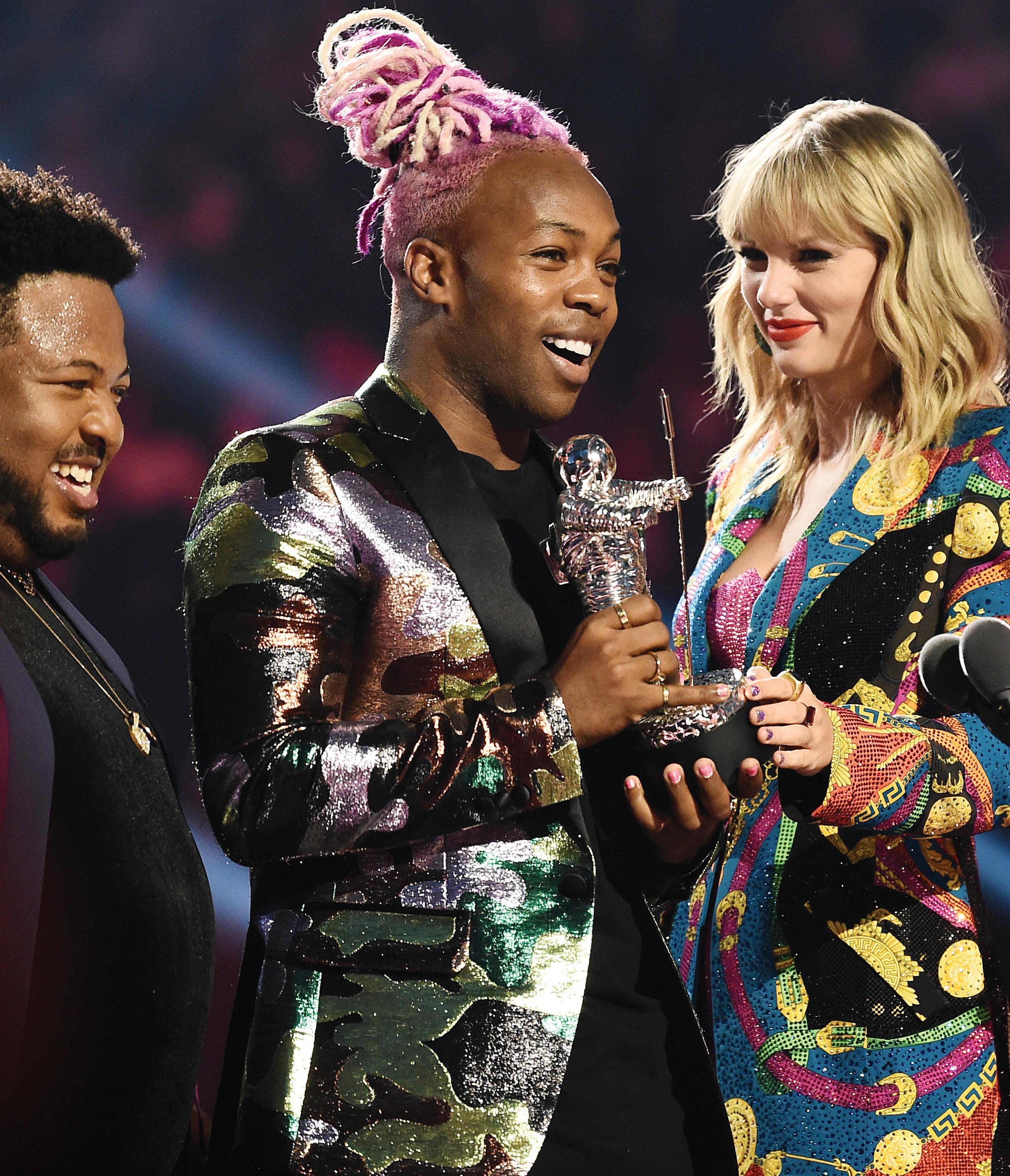
16 MAY / JUNE 2024
Todrick Hall and Taylor Swift receive the ‘Video For Good’ award onstage at the 2019 MTV Video Music Awards.

Some people will love what you do, and some will never be fans. Give your attention to people who will defend you in rooms you’re not in.
In addition, Hall has also collaborated with stars like Beyoncé, Taylor Swift, Ariana Grande, RuPaul, Chaka Khan, Brandy, Billy Porter, Gwen Stefani, Kristin Chenoweth, Jenifer Lewis, Tyra Banks, Tiffany Pollard, Bob the Drag Queen, Monét X Change, and Tiffany Haddish. To date, he’s written, co-produced, and released 17 studio albums.
Despite all his success, Hall has also experienced some of the pitfalls of fame in our internet-driven world, and has occasionally received backlash from folks online throughout his career. These days, however, he says he’s learned to weather such storms by focusing on those who do love and support him.
“Life is good. Rumors come and go,” Hall says. “Some people will love what you do, and some will never be fans. Give your attention to people who will defend you in rooms you’re not in. Invest your time in people who make time to see you. And trust those who don’t assure you that you can. Real ones prove themselves, they don’t need to campaign.”
While he’d already performed onstage in several productions, including The Color Purple, Memphis: The Musical, Beauty and the Beast, and Hairspray, Hall got his first big lead role playing Lola in a Broadway production of Kinky Boots in 2016. He followed that by landing another great part as Billy Flynn in Chicago from 2017-2018 on Broadway and London’s West End. And now, he’s preparing to star in the highly anticipated Burlesque musical this summer.
“The last several years of my life have been dedicated to writing for myself, as a music artist,” Halls says of returning to the stage. “So when the team for Burlesque reached out about contributing songs, I did what I always do — wrote songs and recorded the demos. I
DIMITRIOS KAMBOURIS/GETTY IMAGES
HIVPLUSMAG.COM 17

TRISTAN FEWINGS/GETTY IMAGES
Todrick performs on the main stage at the “We Are Fabuloso” festival during 2022’s Brighton Pride event in England.
It is important to draw attention to the issue as it is still very much an issue in the LGBT+ community and beyond.
think the part was ultimately offered to me because I had composed for this character with my own abilities as a singer in mind, and the creative team had been listening to me singing the songs over and over.”
“But I’m very excited to create a character from start to finish. In my other theater work, I was stepping into someone else’s shoes. I loved playing Lola in Kinky Boots,” he explains. “Billy Flynn in Chicago was also fun to do, but it’s probably the least ‘me’ I have been cast to play. And when a production has been running for 25 years, there’s little room to add your own flair… there is an expectation from the audience.”
Another current project he’s working on, called U.G.L.Y., is the first since the launch of Todrick Hall Musicals. The studio cast recording will feature Tony Award winners Kristin Chenoweth and J. Harrison Ghee, as well as performances by Nick Adams, Wayne Brady, Derek Klena, Tiffany Mann, Orfeh, and Hall himself.
“This is bespoke for my new company,” he says. “It is my version of The Ugly Duckling, and I really lean into the othering of the main character. It’s something I really relate to as a Black man, as a queer person, and as an artist. ‘March to the beat of your own drum’ is a great bit of advice, but I encourage people to build their own drum and then play it so well that they can’t deny how special you are.”
In addition to his many achievements in the entertainment industry, Hall has always been
a loyal advocate for many causes, especially those that affect the communities he’s a part of. Organizations he’s helped support include Broadway Cares/Equity Fights AIDS, Covenant House, and Black Queer Town Hall. In March of this year, he headlined the Florida AIDS Walk and Music Festival.
“It is important to draw attention to the issue as it is still very much an issue in the LGBT+ community and beyond,” says Hall. “Some people think of AIDS and HIV as things we ‘used to’ deal with. While I am very grateful for the advancements the medical community have made to treat HIV/AIDS, there are still over a million people living with HIV in the U.S. who don’t even know it. I am committed to supporting organizations like the Florida AIDS Walk and Music Festival because they understand we need to continue to work together to educate people about this epidemic.”
So what keeps Hall, one of the busiest people in entertainment, happy, healthy, and sane?
“As far as caring for myself, creativity is a natural high. I don’t stay out all night and party,” he says. “I’m not a thrill seeker. I don’t drink. I don’t do drugs — although I eat an unhealthy amount of gummi bears. I don’t enjoy what many people do to blow off steam, or to feel free. A good night out to me is a yummy dinner, a Broadway show, a post-show talk, cuddling with my boyfriend, and falling asleep in my comfy bed.”
HIVPLUSMAG.COM 19
FOOD FOR THOUGHT
Can fasting diets really reduce a person’s “biological age” and risk of disease?
BY NEAL BROVERMAN
Anew study from the University of Southern California found immense benefits from periodic fasting, where people eat a very reduced diet for five days a month.
“Cycles of a diet that mimics fasting can reduce signs of immune system aging, as well as insulin resistance and liver fat in humans, resulting in a lower biological age,” according to a statement from the USC Leonard Davis School of Gerontology.
Researchers refer to the diet as a fastingmimicking diet (FMD) and describe it as high in unsaturated fats and low in overall calories,
protein, and carbohydrates. Participants in the study, who ranged in age from 18 to 70, ate a FMD “composed of plant-based soups, energy bars, energy drinks, chip snacks, and tea portioned out for five days as well as a supplement providing high levels of minerals, vitamins and essential fatty acids.” Control group participants consumed a regular diet or a Mediterranean-style diet.
The study followed people for three or four month cycles, with five days of each month carved out for FMD. The results showed a huge range of benefits, with lower diabetes risk factors, a decrease in abdominal fat as well as fat within the liver, improvements associated with a reduced risk of metabolic syndrome. FMD cycles also increased the lymphoidto-myeloid ratio, “an indicator of a more youthful immune system,” according to USC researchers. FMD participants reduced their biological age by 2.5 years on average, with their cells and tissue functioning better than before the fast-like diet. Researchers were impressed by the many signs of improved health that occurred without prescriptions or other major medical interventions.
“This is the first study to show that a food-based intervention that does not require chronic dietary or other lifestyle changes can make people biologically younger, based on both changes in risk factors for aging and disease and on a validated method to assess biological age,” study author Valter Longo said in a statement. “Although many doctors are already recommending the FMD in the United States and Europe, these findings should encourage many more health care professionals to recommend FMD cycles to patients with higher than desired levels of disease risk factors as well as to the general population that may be interested in increased function and younger age.”

KAMPUS PRODUCTION/PEXELS well ness

8 Dating Tips for Gay Men
From a Gay Psychotherapist
Love feeling out of reach? Take a breath and then take action.
BY ADAM D. BLUM
LOOKING FOR A long-term relationship? Here are some tips based on my 18 years as a psychotherapist working exclusively with gay men and as founder of the Gay Therapy Center. These suggestions are also informed by clinical research on relationships as well as my personal research as a recent dater.
Men Are Avoidant
Generally speaking, women are socialized to connect. Men, not so much. That’s why they are so lonely. So you’ll increase your chances of success if you take a chance on opening up, being real, and a just little more vulnerable than your average gay male dater. That doesn’t mean spilling your guts on the first date. But can you stretch a little and be the first to be more authentic?
Looks Aren’t Everything
If you read and watch social media targeted to gay men you get the sense that all we care about is big dicks and pecs. While these posts may get our attention in the digital age and make good money for advertisers, they do not correlate as primary features of a lasting relationship. Here are some better indicators of a relationship that will last: Does your guy’s eyes light up when he sees you after a few days away? Do you feel like you can be yourself with him? Is he showing you kindness? Some gay men focus solely on beauty when they date. In therapy we sometimes find this is driven by low self-esteem.
Dating Apps Tips
At some point every dater will hate the dating apps. You’ll find criminals and liars on the apps. You’ll get ghosted. However, they are a very useful tool for making dates.
Gay men are a minority which means we’ve got fewer potential mates. You will run out of potential matches if you limit yourself to one app. So try a few. In my opinion the best apps for serious gay daters are Match, OK Cupid, and Hinge. If your focus is hook-ups then it’s better to spend time on Grindr, Sniffies, and Scruff. Tinder is somewhere in between a hook-up app and a dating app.
If you limit the time you spend texting by moving as quickly as possible to a brief in-person date, you’ll avoid wasting a lot of your life texting people with whom you will never meet.
The Myth of Immediate Chemistry
The film industry has convinced us that we should feel an immediate desire for our partner. However research tells us that only 11 percent of couples have a “love at first sight” moment. Most successful couples start with mild attraction that builds over time. Many gay men make the mistake of dropping someone if their first sexual encounter is “meh.” The truth is, for most men it takes time to build sexual confidence and creativity with a new partner.
Finding Gay Men Who Want to Date
The internet comment section will tell you that gay men don’t want commitment. This is false. Gay men who are in the party scene may be more interested in sex than in relationships. You can increase your chances for longterm relationships if you spend some time outside of the clubs and bars. Gay men who are members of LGBTQ+ organizations have already shown they have some capacity to commit to something. This is fertile hunting ground for a longterm partner. Check out LGBTQ+ political, athletic, charitable, and artistic groups in your area; also try meetup.com. You will make friends and, even perhaps, boyfriends. And, by the way, most research shows that 50 percent of gay men are in monogamous relationships even though “everyone” tells you that all gay men are open. If you want monogamy, it is available.
Marketing Mindset
Do you have friends who do marketing for a living? They’ll tell you that you can’t just do one thing to be successful. To expand exposure, marketers and daters need to post ads, go to events, and talk to strangers. Simply relying on a dating app may not be enough to achieve your goals. Is finding a partner a lot of work? Yes it is. But what could be more important? The good news is that everyone likes to talk about dating. Bring up the topic with friends, acquaintances, and people at parties. They will immediately tell you their own dating stories. Let them know you are available if they know a good man. This worked for me.
Hope and Action
Finding a partner takes a ready supply of hope, coupled with real life action. You will experience burn out and rejection. It is a normal part of the process. Take regular breaks from dating whenever you need to. Remind yourself that although dating is difficult, each time you try you are learning and growing.
It Takes A Village
Dating is an emotional journey. Don’t do it alone. Find a friend, dating coach, or a therapist you can share the highs and lows with. You’ll need support when there is rejection, you’ll want a second opinion when you are confused, and it feels great to share the excitement when a date go well.
ADAM D. BLUM, MFT is a licensed psychotherapist and the founder of the Gay Therapy Center, the largest private therapy provider for the LGBTQ community in the U.S., with offices in San Francisco, Los Angeles, New York, Washington D.C. and online services available worldwide.
HIVPLUSMAG.COM 21 PEXELS/ NICHOLAS SWATZ
U=U THROUGH THE YEARS
This important movement has been slowing the spread of HIV while liberating people living with the virus.
BY DESIRÉE GUERRERO
The U=U movement has been evolving alongside the HIV epidemic for decades. “Undetectable equals untransmittable,” more popularly known as U=U, is the globally-accepted scientific consensus that continues to change the lives of people living with HIV — and has also become one of our most vital tools in the fight to eliminate the virus. U=U simply means that an HIV-positive person who is on treatment and has achieved an undetectable viral load also has a zero chance of transmitting the virus to a sexual partner, even without the use of a condom.
Here’s a look back on how science and radical activism have worked together through the years to harness the power of U=U.
1980s — early ’90s
During what is now often referred to as the “AIDS era,” early medications available to treat HIV were largely ineffective and came with toxicity levels that often did more harm than good to the bodies of those prescribed it. Tragically, many diagnosed during this time ultimately did not survive, and many of those who did suffered from debilitating drug side effects and other complications, not to mention PTSD (posttraumatic stress disorder) from losing so many friends and lovers. It was a dark and difficult time, and one we still bear the scars of.
And while tens of thousands were sick and dying from the virus at the time, the government (primarily, the rightwing Reagan and Bush administrations) largely ignored the epidemic, most likely because HIV only seemed to largely affect queer communities. This lack of federal response would end up birthing a powerful rise in activism, with the formation of groups like ACT UP, which staged radical demonstrations and protests in order to bring national awareness to the issue of HIV and AIDS.

1996
By this time, major scientific advancements in HIV treatment had changed everything. Antiretroviral treatment (ART) drugs were finally made available to the public and proved to be highly effective in stopping the spread of HIV within the body — and researchers would soon discover that, once on treatment, people living with HIV could quickly achieve an undetectable viral load.
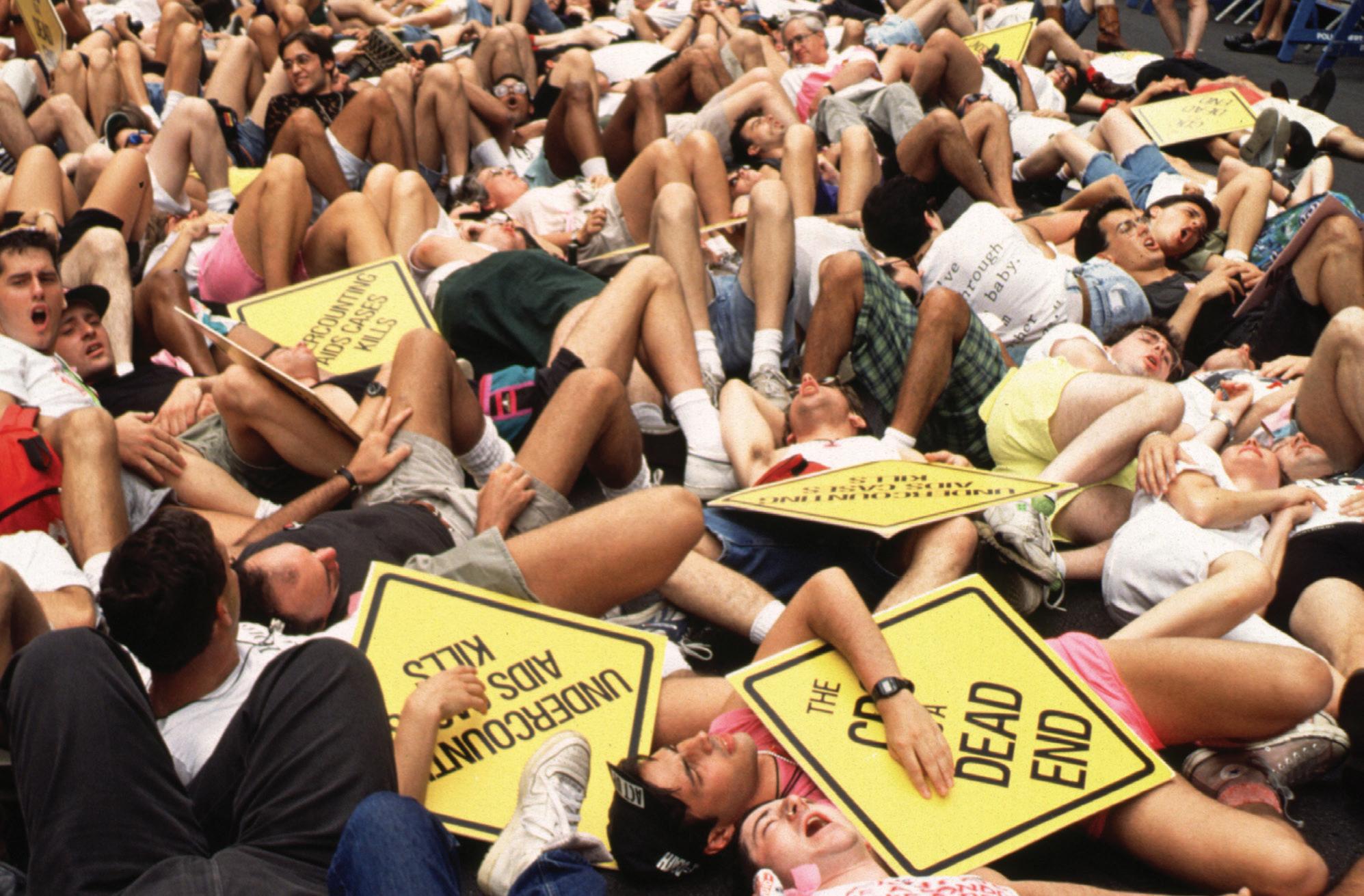
2006
Dr. Julio Montaner, a pioneering physician and HIV researcher, first introduced the concept of “Treatment as Prevention,” also known as TasP. Montaner was one of the first experts to hone in on the idea that getting people on treatment was a key factor in preventing the transmission of HIV, and ultimately ending the epidemic. The introduction of TasP marked the true beginnings of the U=U movement.
CATHERINE MCGANN/GETTY IMAGES (TOP); ANDREW HOLBROOKE/GETTY IMAGES (BOTTOM)
2016
A group of HIV activists formed the Prevention Access Campaign (PAC) and first coined the term “U=U.”
“U=U is my calling,” Bruce Richman, a lawyer-turnedactivist and founder of PAC, told Plus in 2020. “I knew that undetectable equals untransmittable, but millions of people were suffering because they were not being told, and people in positions of great influence to alleviate that suffering were sitting on their hands. I had no choice.”
PAC continues to grow as an organization and be one of the world’s most powerful voices in spreading the U=U message on a global scale.
2022
Deondre Moore is a public health advocate living with HIV since the age of 19. His moving speech at the 2022 Presidential Advisory Council on HIV/AIDS (PACHA) meeting was instrumental in getting the White House to recognize U=U.
“With your leadership and support, we can measure, optimize, and scale up the impact U=U has on improving the health, wellbeing, and emotional wellness of people living with HIV,” Moore said at the PACHA meeting. “This will also prevent new transmissions. Embracing U=U is a win-win.”
In December of that year, the Biden-Harris administration announced its official endorsement of U=U to further its “efforts to end HIV/AIDS at home and abroad.”
2024
At the GLAAD Awards ceremony in March in Beverly Hills, California, Oprah Winfrey was honored for her years of allyship to the LGBTQ+ community. While accepting the Vanguard Award, Winfrey spent much of her time onstage speaking about HIV and the AIDS crisis. She became emotional after sharing that her brother Lee died from HIVrelated complications 35 years ago at age 29.
Winfrey also mentioned late activist Hydiea Broadbent (see page 6), who the media icon interviewed when Broadbent was 11 years old, noting she “used her life empowering others and she showed us that people living with HIV today, when on effective treatment, can live healthy lives and do not transmit HIV.”



HIVPLUSMAG.COM 23
COURTESY PAC (RICHMAN): KOLLIN BENSON (MOORE); GETTY IMAGES FOR GLAAD (WINFREY)
Founder of Prevention Access Campaign Bruce Richman
Oprah Winfrey and GLAAD president Sarah Kate Ellis
Heatlh advocate and public speaker Deondre Moore
SCARLET FEVER
Long-held fears of violence, illness, and even menstruation have colored the way we deal with blood.
BY NEAL BROVERMAN
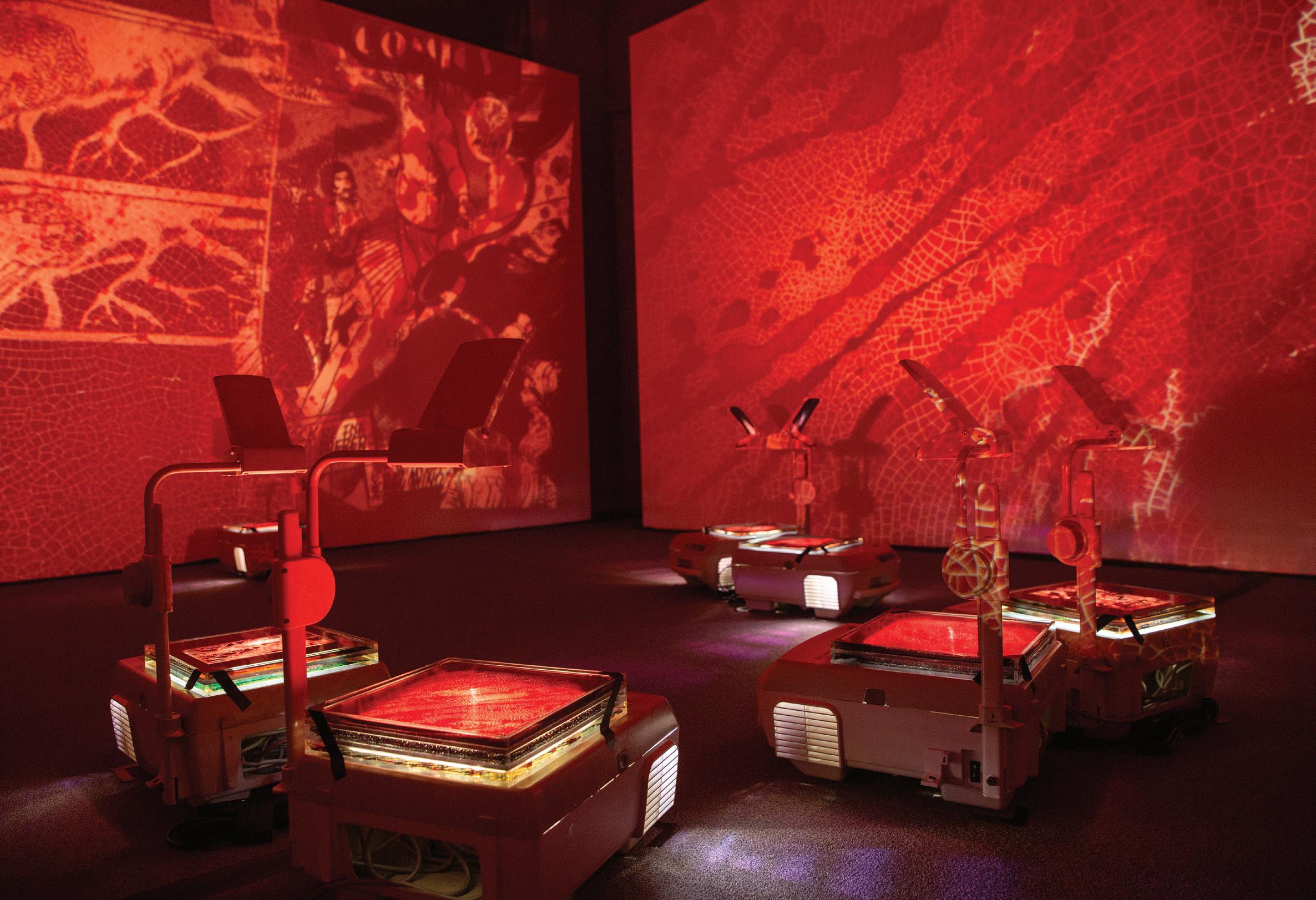
In medieval Europe, blood was a fascination; frightening, powerful, mysterious. Centuries later, the bright red liquid pulsing through our bodies continues to spark extreme reactions, especially when it’s depicted in art, movies, or even sneakers.
The new exhibit at Los Angeles’s J. Paul Getty Museum, Blood: Medieval/Modern , draws connections between those two time periods and how our concepts of this bodily fluid have — and have not — evolved. Much of the exhibition focuses on how Medieval artists, writers, and religious leaders thought of blood, especially in the context of Christianity and Jesus Christ. Aside from the many pieces of art that showcased Christ’s wounds, the Middle Ages also produced much “medical discourse” about blood, according to Getty curators, “ranging from the practical treatment of disease through blood analysis, bloodletting as a cure, menstruations, and a growing understanding of the human circulatory system.”
Blood: Medieval/Modern also looks at contemporary depictions of blood, including when modern artists and tastemakers use
it to make points about feminism, DNA, and HIV and AIDS. Included in the exhibit are works by legendary artists Catherine Opie, Andres Serrano, and Nan Goldin, as well as art collective MSCHF, which helped create the so-called “Satan Shoes” promoted by out rapper Lil Nas X in 2021 and containing a drop of human blood (the $1,018 shoes sold out in less than a minute).
New York-based artist Jordan Eagles is also featured prominently in the Getty exhibit; the artist has been making art centered on the blood of gay and bisexual men for decades, hoping to draw attention to HIV panic and the U.S. government’s discrimination on blood donations from this marginalized group. Featured in Blood: Medieval/Modern is Eagles’s “Queer Blood America” from 2021, a thoughtprovoking work depicting a vial of a gay man’s blood placed over the cover of a Captain America comic book from the early days of AIDS; crumpled up surgical gloves surround the image. A pop-up installation of Eagles’, “Illuminations,” also appeared at the Getty in early March. The resin panels of “Illumination” contain blood donated
JORDAN EAGLES/GETTY
ABOVE “Illuminations” installation by Jordan Eagles
ACROSS “Ecce Homo, from Poncher Hours” by Jean Pichore, circa 1500
24 MAY / JUNE 2024

HIVPLUSMAG.COM 25 COURTESY GETTY MUSEUM

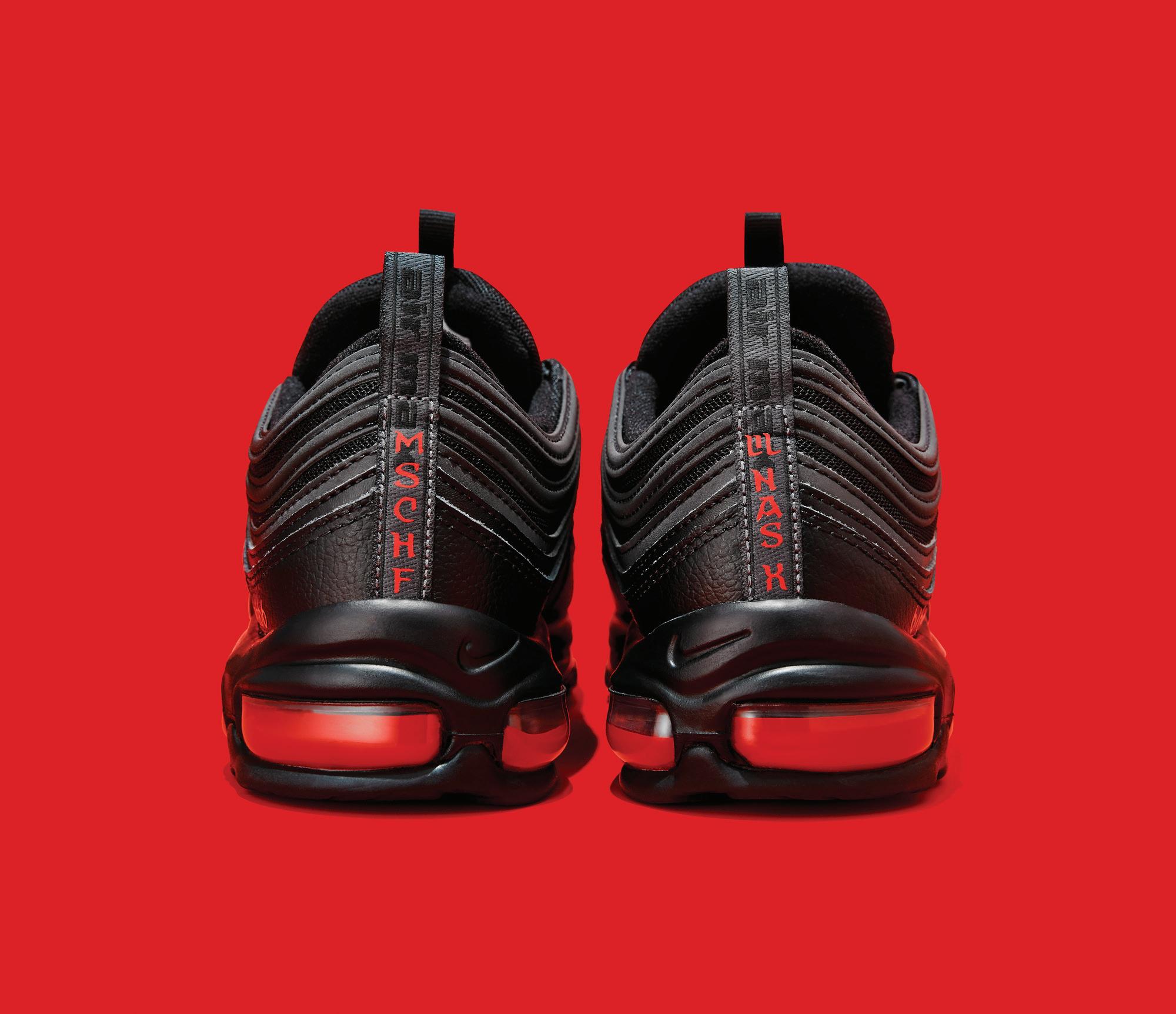
MSCHF/GETTY
“Satan Shoes” by MSCHF and Lil Nas X contain human blood

from LGBTQ+ people, some on PrEP and others living with HIV but undetectable, with comic book images laid over the blood and projectors turning the whole installation a foreboding red.
“Current blood donation policies are biased and contribute to preventing full equality for the LBGTQI+ community, and my work addresses these issues by confronting the inherent discrimination and stigma,” Eagles tells Plus. (The Food and Drug Administration removed restrictions on blood donations for gay and bisexual men in monogamous relationships last year, but still makes individuals who’ve had anal sex with new partners or more than one partner wait to donate blood.)
“In the work ‘Queer Blood America,’ which is included in the exhibition, Blood: Medieval/ Modern, and the installation ‘Illuminations,’ both utilize vintage comic book images with narratives that relate to blood and/or HIV/ AIDS, paired with blood donated by members of the LGBTQI+ community, creating new entry points to examine these biased policies,” Eagles adds. “By integrating the blood of an individual who is HIV+ and undetectable, and a gay man on PrEP, I want to highlight how the tragic or dated storylines of these comics from the ’70s, ’80’s, and ’90s would be very different, if not irrelevant, today because of the progress in science, treatment, and prevention.”
Blood: Medieval/Modern, curated by Larisa Grollemond, is on display at the Getty until May 19. Go to getty.edu for more information.

HIVPLUSMAG.COM 27
MSCHF/GETTY (TOP); JORDAN EAGLES/GETTY (BOTTOM)
BELOW Jordan Eagles’s “Queer Blood America” features a vial filled with a gay man’s blood
LEFT
The elaborately decorated box for MSCHF and Lil Nas X’s “Satan Shoes”
RESISTANCE RESCUE
The FDA OK’s the use of Biktarvy for HIV-positive people with a common type of treatment resistance.
BY NEAL BROVERMAN
Good news for those living with HIV — the federal Food and Drug Administration announced in March that Gilead Sciences’ Biktarvy can be used by people living with HIV (PLWH) who are struggling with M184V/I resistance, a common form of treatment resistance.
Biktarvy, a once-daily pill used to treat HIV, can now be used by people with suppressed viral loads but also dealing with M184/I resistance. The M184V/I resistance mutation has been found to be present in a range of PLWH with pre-existing resistance to nucleoside reverse transcriptase inhibitors.
“Clinical data have established Biktarvy as a longterm HIV treatment option for a broad range of PWH. With this label update, healthcare providers have a better understanding of the efficacy of Biktarvy in an underserved segment of PWH,” said Dr. Jared Baeten, vice president of HIV Clinical Development at Gilead Sciences, in a statement. “Thanks to decades of therapeutic improvements, PWH may live longer, healthier lives, but treatment needs remain. Treatment resistance is one such area. We are committed to a person-centered approach to HIV treatment research that not only advances continuous scientific innovations to help
address public health needs, but also maximizes long-term outcomes for PWH.”
Treatment resistance is a serious problem; once someone with HIV develops such resistance, it’s permanent and irreversible. HIV drug resistance could lead to one’s regimen failing to stop the replication of the virus, as well as potentially leading to transmission of HIV to others if the resistance leads to a person’s viral load no longer being suppressed.
“Treatment failure in HIV must be avoided whenever possible, so a high barrier to resistance should be standard of care to maximize the chances of durable virologic suppression,” said Dr. Paul E. Sax, clinical director of the Division of Infectious Diseases at Brigham and Women’s Hospital and a professor of medicine at Harvard Medical School. “This label update builds on the established high resistance barrier of Biktarvy by showing that it’s effective in PWH who may have certain forms of pre-existing resistance or a history of past treatment failure.”
Relatedly, it was announced last year that Biktarvy has also been proven safe for use by pregnant individuals in recent studies.
28 MAY / JUNE 2024 SHUTTERSTOCK
THE FUTURE OF PrEP?
This new “combo” prevention method could lead to an astounding reduction of HIV transmissions.
IF THOSE AT risk of contracting HIV began taking both a long-acting injectable form of PrEP as well as a daily pill, it could yield enormous results for public health, according to an updated report from the HIV+Hepatitis Policy Institute.
The number of HIV cases averted would be 87 percent higher if people were prescribed both the oral and longacting treatments, compared to using only daily oral PrEP, leading to medical cost savings of $4.25 billion over 10 years; “139,296 person-years of HIV treatment would be averted over ten years,” according to a statement from the Institute. By comparison, assuming only oral PrEP use over a decade, only 74,540 person-years of HIV treatment would be averted, with medical cost savings of $2.27 billion.
The difference in results, according to the latest research, is because of higher user adherence of the long-acting injectable compared to the daily pill.
Only about 36 percent of people who the Centers for Disease Control believe should be on PrEP are currently on it, with many members of marginalized communities, including Black and transgender people, at risk of contracting HIV because they are not on the preventative medication.
“We must make sure that everyone with a reason to be on PrEP is able to access the medication best suited to their needs. With new long-acting PrEP, many people who have had a hard time adhering to a regimen of a daily pill now have another option to prevent HIV,” Carl Schmid, executive director of the HIV+Hepatitis Policy Institute, said in a statement. “And we now know that more cases of HIV can be averted and medical costs can be saved by gradually increasing the uptake of long-acting PrEP. This must be taken into account as we develop policies and programs regarding the use and coverage of PrEP.”—NB

HIVPLUSMAG.COM 29 ARTŪRAS LOKOREVAS/PEXELS treat ment
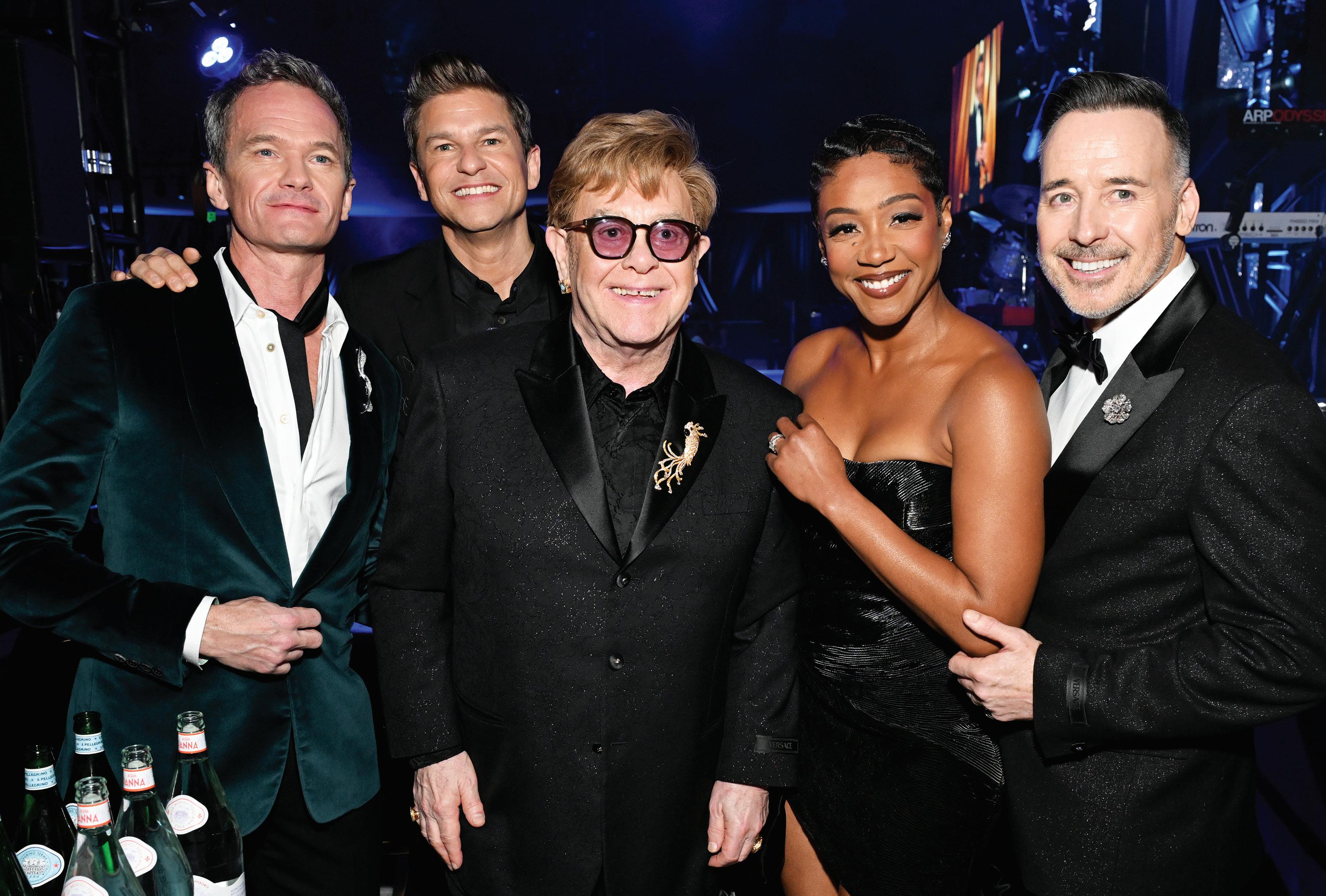
PARTY AT ELTON’S
The most fabulous Oscar event of the year also raised millions for HIV causes.
BY RICKY CORNISH
THE 32ND ANNUAL Elton John AIDS Foundation Academy Awards Viewing Party took place on Oscar night this year in West Hollywood, California, and celebrities from every corner of entertainment showed their support. Cohosted by Tiffany Haddish, Elton John and husband David Furnish, and Neil Patrick Harris and husband David Burtka, the event raised a record-breaking $10.8 million in support of the foundation’s passionate work to end the HIV/ AIDS epidemic.
Guests included Sharon Stone, Orville Peck, Michaela Jaé Rodriguez, Dexter Mayfield, Chris Colfer, Elizabeth Hurley and son Damien, Johnny Sibilly, Billy Eichner, and many others. Drag superstars Sasha Colby, Manila Luzon, and Gigi Goode were also in attendance.
“I’m proud to be part of that community,” Furnish said. “The advocates are real heroes and real fighters. We’re just continuing that fight by making sure that people get access to those medications that they fought so hard for.”

30 MAY / JUNE 2024 parting shot
MICHAEL KOVAC/GETTY IMAGES FOR ELTON JOHN AIDS FOUNDATION (HOSTS); MONICA SCHIPPER/GETTY IMAGES FOR ELTON JOHN AIDS FOUNDATION (LUZON)
LEFT TO RIGHT
The evening’s hosts, Neil Patrick Harris, David Burtka, Elton John, Tiffany Haddish, and David Furnish Manila Luzon



SCHIPPER/GETTY IMAGES FOR ELTON JOHN AIDS FOUNDATION (RODRIGUEZ); FRAZER HARRISON/ GETTY IMAGES (HADDISH); VIVIEN KILLILEA/GETTY IMAGES FOR TEQUILA DON JULIO (GROUP)
CLOCKWISE FROM TOP RIGHT Ashlyn Harris, Bobby Berk, and Stephanie Nguyen get smoochy; Michaela Jaé Rodriguez; Tiffany Haddish hams it up on the red carpet
MONICA




parting shot 32 MAY / JUNE 2024
CLOCKWISE FROM TOP Michaela Jaé Rodriguez, Lucien Laviscount, Andrew Watt, David Furnish, Charlotte Lawrence, Brandi Carlile, and Elton John; Elton John performs onstage with hubby David Furnish by his side; Alicia Silverstone, Christian Siriano, and Billy Eichner; Mario Cantone and Jennifer Tilly
TEQUILA DON JULIO
TILLY);
MICHAEL
KOVAC/GETTY IMAGES FOR ELTON JOHN AIDS FOUNDATION (GROUP); VIVIEN KILLILEA/ GETTY IMAGES FOR
(CANTONE &
MICHAEL KOVAC/ GETTY IMAGES FOR ELTON JOHN AIDS FOUNDATION (ELTON ON STAGE); THEO WARGO/GETTY IMAGES FOR ELTON JOHN AIDS FOUNDATION (SILVERSTONE, SIRIANO, EICHNER)









































OUR COMMUNITY. SHOP
WELCOME TO THE NEW ERA OF SHOPPINGEXPLORE CURATED LGBTQ+ AND ALLIED BRANDS!
REALPRIDESTORE
JOIN
EQUALITY.
@
Starting + Staying
You can live well with HIV on HIV treatment
The best time to start treatment is ASAP after diagnosis

By starting HIV treatment as soon as possible after diagnosis and staying on treatment as prescribed, you can help control your HIV viral load, which can help you live a longer and healthier life.
Today’s HIV treatments can fit into your schedule, and some can even be started right away. So be sure to talk to your healthcare provider about what’s right for you.
And remember, you are not alone. There are many people to help support you, alongside your healthcare provider.
Work together with your healthcare provider to find an HIV treatment option that is right for you and start your treatment journey today.

GILEAD and the GILEAD Logo are trademarks of Gilead Sciences, Inc. All other trademarks are the property of their respective owners. © 2023 Gilead Sciences, Inc. All rights reserved. US-UNBC-1092 01/23
treatment strategies and different kinds of support at HelpStopTheVirus.com
Find
Model portrayal
Model portrayal





























































 Desirée Guerrero editor in chief
Mark Berryhill CEO, equalpride
Desirée Guerrero editor in chief
Mark Berryhill CEO, equalpride












































































